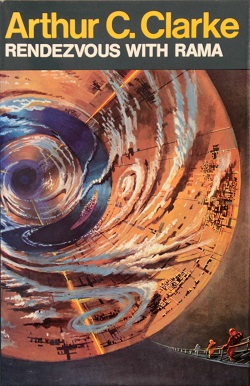
Rendezvous with Rama is a 1973 science fiction novel by British writer Arthur C. Clarke. Set in the 2130s, the story involves a 50-by-20-kilometre cylindrical alien starship that enters the Solar System. The story is told from the point of view of a group of human explorers who intercept the ship in an attempt to unlock its mysteries. The novel won both the Hugo and Nebula awards upon its release, and is regarded as one of the cornerstones in Clarke's bibliography. The concept was later extended with several sequels, written by Clarke and Gentry Lee.
Unobtainium is a term used in fiction, engineering, and common situations for a material ideal for a particular application but impractically difficult or impossible to obtain. Unobtainium originally referred to materials that do not exist at all, but can also be used to describe real materials that are unavailable due to extreme rarity or cost. Less commonly, it can mean a device with desirable engineering properties for an application that are exceedingly difficult or impossible to achieve.

Apocalyptic and post-apocalyptic fiction is a subgenre of science fiction in which the Earth's civilization is collapsing or has collapsed. The apocalypse event may be climatic, such as runaway climate change; astronomical, such as an impact event; destructive, such as nuclear holocaust or resource depletion; medical, such as a pandemic, whether natural or human-caused; end time, such as the Last Judgment, Second Coming or Ragnarök; or any other scenario in which the outcome is apocalyptic, such as a zombie apocalypse, cybernetic revolt, technological singularity, dysgenics or alien invasion.

The China Syndrome is a 1979 American disaster thriller film directed by James Bridges and written by Bridges, Mike Gray, and T. S. Cook. The film stars Jane Fonda, Jack Lemmon, Michael Douglas, Scott Brady, James Hampton, Peter Donat, Richard Herd, and Wilford Brimley. It follows a television reporter and her cameraman who discover safety coverups at a nuclear power plant. "China syndrome" is a fanciful term that describes a fictional result of a nuclear meltdown, where reactor components melt through their containment structures and into the underlying earth, "all the way to China".

Science fiction is a film genre that uses speculative, fictional science-based depictions of phenomena that are not fully accepted by mainstream science, such as extraterrestrial lifeforms, spacecraft, robots, cyborgs, mutants, interstellar travel, time travel, or other technologies. Science fiction films have often been used to focus on political or social issues, and to explore philosophical issues like the human condition.
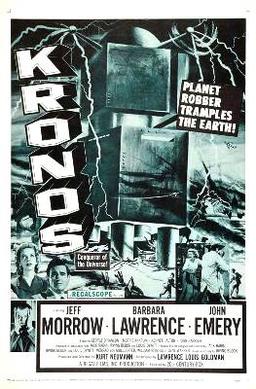
Kronos is a 1957 American black-and-white science fiction film from Regal Films, a division of 20th Century-Fox. It was produced by Irving Block, Louis DeWitt, Kurt Neumann, and Jack Rabin, directed by Kurt Neumann, and stars Jeff Morrow and Barbara Lawrence. Kronos was distributed as a double feature with She Devil.
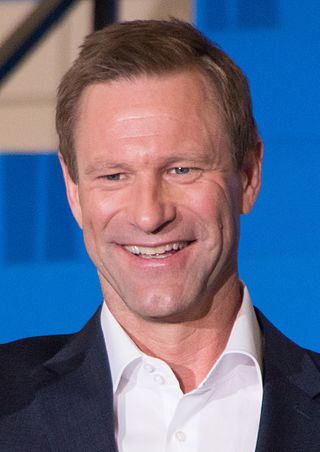
Aaron Edward Eckhart is an American actor. Born in Cupertino, California, Eckhart moved to the United Kingdom at an early age. He began his acting career by performing in school plays, before moving to Australia for his high school senior year. He left high school without graduating, but earned a diploma through a professional education course, and then graduated from Brigham Young University (BYU) in Utah, U.S., in 1994 with a Bachelor of Fine Arts degree in film.

Subterranean fiction is a subgenre of adventure fiction, science fiction, or fantasy which focuses on fictional underground settings, sometimes at the center of the Earth or otherwise deep below the surface. The genre is based on, and has in turn influenced, the Hollow Earth theory. The earliest works in the genre were Enlightenment-era philosophical or allegorical works, in which the underground setting was often largely incidental. In the late 19th century, however, more pseudoscientific or proto-science-fictional motifs gained prevalence. Common themes have included a depiction of the underground world as more primitive than the surface, either culturally, technologically or biologically, or in some combination thereof. The former cases usually see the setting used as a venue for sword-and-sorcery fiction, while the latter often features cryptids or creatures extinct on the surface, such as dinosaurs or archaic humans. A less frequent theme has the underground world much more technologically advanced than the surface one, typically either as the refugium of a lost civilization, or as a secret base for space aliens.

The Black Dahlia is a 2006 American neo-noir crime thriller film directed by Brian De Palma and written by Josh Friedman, based on the 1987 novel of the same name by James Ellroy, in turn inspired by the widely sensationalized murder of Elizabeth Short. Starring Josh Hartnett, Scarlett Johansson, Aaron Eckhart, and Hilary Swank, the film follows two Los Angeles Police Department detectives investigating Short's murder, leading them through a series of shocking discoveries. Mia Kirshner, Mike Starr, Fiona Shaw, John Kavanagh, Rachel Miner, and Rose McGowan appear in supporting roles.
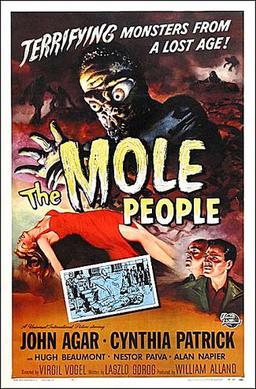
The Mole People is a 1956 American science fiction adventure horror film distributed by Universal International, which was produced by William Alland, directed by Virgil W. Vogel, and stars John Agar, Hugh Beaumont, and Cynthia Patrick. The story is written by László Görög. The film was released on December 1, 1956, on a double feature with their jungle adventure film Curucu, Beast of the Amazon. It has also been featured on episodes of Mystery Science Theater 3000 and Svengoolie.

Crack in the World is a 1965 American science-fiction doomsday disaster movie filmed in Spain. It is about scientists who launch a nuclear missile into the Earth's crust, to release the geothermal energy of the magma below; but accidentally unleash a cataclysmic destruction that threatens to sever the earth in two. It was released by Paramount Pictures on February 24, 1965.

The Andromeda Strain is a 1971 American science fiction thriller film produced and directed by Robert Wise. Based on Michael Crichton's 1969 novel of the same name and adapted by Nelson Gidding, the film stars Arthur Hill, James Olson, Kate Reid, and David Wayne as a team of scientists who investigate a deadly organism of extraterrestrial origin. With a few exceptions, the film follows the book closely. The special effects were designed by Douglas Trumbull. The film is notable for its use of split screen in certain scenes.
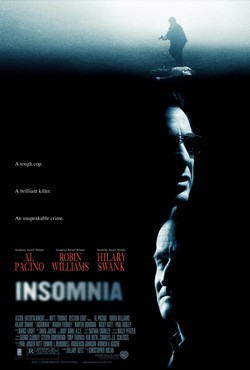
Insomnia is a 2002 American psychological thriller film directed by Christopher Nolan and written by Hillary Seitz. It is the only film directed by Nolan that he neither wrote nor cowrote. A remake of the 1997 Norwegian film of the same name, it stars Al Pacino, Robin Williams and Hilary Swank, with Maura Tierney, Martin Donovan, Nicky Katt and Paul Dooley in supporting roles.
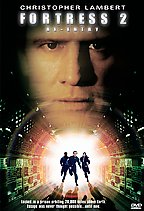
Fortress 2: Re-Entry is a 2000 American-Luxembourgish science fiction action film directed by Geoff Murphy. It is the sequel to 1992's Fortress. In the film, the principal actor Christopher Lambert reprises his role as John Henry Brennick, still on the run from the MenTel Corporation. Lambert was the only original actor to reprise his role; Loryn Locklin, who played Karen B. Brennick from the first film, did not return for the sequel and she was played by Beth Toussaint.

Travelling to the Earth's center is a popular theme in science fiction. Some subterranean fiction involves traveling to the Earth's center and finding either a Hollow Earth or Earth's molten core. Planetary scientist David J. Stevenson suggested sending a probe to the core as a thought experiment. Humans have drilled over 12 kilometers in the Sakhalin-I project. In terms of depth below the surface, the Kola Superdeep Borehole SG-3 retains the world record at 12,262 metres (40,230 ft) in 1989 and still is the deepest artificial point on Earth.

Epoch is a 2001 science fiction film directed by Matt Codd, starring David Keith, Stephanie Niznik, Brian Thompson, and Shannon Lee. The film concerns the discovery of a strange and mysterious monolith, and the tribulations faced by the team sent to study it.
In his lifetime Arthur C. Clarke participated in film, television, radio and other media in a number of different ways.

Deep Core is a 2000 American action science fiction film. The film was generally poorly received.

Moonfall is a 2022 science fiction disaster film co-written, directed, and produced by Roland Emmerich. It stars Halle Berry, Patrick Wilson, John Bradley, Michael Peña, Charlie Plummer, Kelly Yu, Carolina Bartczak, and Donald Sutherland. It follows two former astronauts alongside a conspiracy theorist who discover the hidden truth about the Moon when it suddenly leaves its orbit. Shot in Montreal on a $138–146 million budget, it is one of the most expensive independently produced films ever made.
















